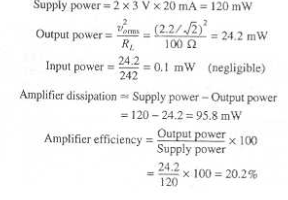This set of Electronic Devices and Circuits Multiple Choice Questions & Answers (MCQs) focuses on “Amplifiers”.
1. An amplifier operating from ±3V provide a 2.2V peak sine wave across a 100 ohm load when provided with a 0.2V peak sine wave as an input from which 1.0mA current is drawn. The average current in each supply is measured to be 20mA. What is the amplifier efficiency?
a) 20.2%
b) 25.2%
c) 30.2%
d) 35.2%
View Answer
2. In order to prevent distortion in the output signal after amplification, the input signal must be
a) Higher than the positive saturation level of the amplifier
b) Lower than the negative saturation level of the amplifier
c) Must lie with the negative and the positive saturation level of the amplifier
d) Both higher than the positive saturation level of the amplifier and lower than the negative saturation level of the amplifier
View Answer
Explanation: Higher than the positive saturation and lower than the negative saturation level of the amplifier are the desired characteristics in order to prevent distortion.
3. The voltage gain of the amplifier is 8 and the current gain is 7. The power gain of the amplifier is
a) 56 db
b) 17.481 db
c) 34.963 db
d) 1 db
View Answer
Explanation: The power gain is given by 10 log (7 X 8) db.
4. Statement 1: Voltage gain of -5 means that the output voltage has been attenuated.
Statement 2: Voltage gain of -5db means that the output voltage has been attenuated.
a) Statement 1 and Statement 2 are true
b) Statement 1 and Statement 2 are false
c) Only Statement 1 is true
d) Only Statement 2 is true
View Answer
Explanation: A negative voltage gain means that a phase difference of 1800 has been introduced in the output waveform when compared to the input waveform. A voltage gain of -5db means that the signal has been attenuated.
5. Which of the following isn’t true?
a) Both transformer and amplifier can provide voltage gain
b) Both transformer and amplifier can provide current gain
c) Both transformer and amplifier can provide power gain
d) None of the mentioned
View Answer
Explanation: For an ideal transformer the power input is always equal to the power output. In real conditions there is slight loss of power when transferring the power from an input source to an output source. Amplifiers only provide power gain.
6. Symmetrically saturated amplifiers operating in clipping mode can be used to convert a sine wave to a
a) Square wave
b) Pseudo Square wave
c) Sawtooth wave
d) Triangular wave
View Answer
Explanation: Clipping circuits with low peak values of the output signals are used to generate pseudo square waves if the input signal is very large as compared to the output signal.
7. What is meant by stability of the an amplified signal?
a) The amplified signal must have a finite amplitude
b) The amplified signal should not have self oscillation
c) The input and the output signal must be proportional
d) The ratio of the input and the output signal must be finite
View Answer
Explanation: The ability of the amplifier to prevent self oscillation is a measure of its stability.
8. If Av, Ai and Ap represents the voltage gain, current gain and power gain ratio of an amplifier which of the below is not the correct expression for the corresponding values in decibel?
a) Current gain: 20 log Ai db
b) Voltage gain: 20 log Av db
c) Power gain: 20 log Ap db
d) Power gain: 10 log Ap
View Answer
Explanation: Power gain is given by 10 log Ap db.
9. An amplifier has a voltage gain of 100 V/V and a current gain of 1000A/A. the value of the power gain decibel is
a) 30 db
b) 40 db
c) 50 db
d) 60 db
View Answer
Explanation: Power gain in db is given by 10 log (100 X 1000) db.
10. The units of voltage gain is
a) It has no units, it is a ratio
b) Decibels (db)
c) All of the mentioned
d) None of the mentioned
View Answer
Explanation: Voltage gain (Vo) = output voltage/input voltage (Vi). It is also expresses as 20 log (Vo/Vi) db.
Sanfoundry Global Education & Learning Series – Electronic Devices and Circuits.
To practice all areas of Electronic Devices and Circuits, here is complete set of 1000+ Multiple Choice Questions and Answers.
If you find a mistake in question / option / answer, kindly take a screenshot and email to [email protected]

